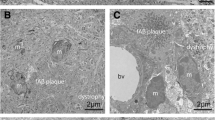Abstract
Activated microglial cells are concentrated in senile plaques characteristic of Alzheimer’s disease. Such accumulations of activated microglia may contribute towards neurodegeneration via production of cytokines and free radicals. Studies suggesting a link between Alzheimer’s disease and heart disease led us to study microglia immunohistochemically, using monoclonal antibody LN-3, in age-matched nondemented humans with and without heart disease. Using a qualitative staging system for assessing morphological changes occurring in microglia, we found higher microglial activation in the brains of subjects with heart disease than in those without it. Lectin histochemical examination of brains from rabbits maintained on a high-cholesterol diet also revealed increased microglial activation and leukocyte infiltration. Collectively our observations from humans and rabbits suggest that hypercholesterolemia and heart disease accelerate brain aging, and that the formation of senile plaques may be the end result of progressive microglial activation that occurs with aging.
Similar content being viewed by others
Author information
Authors and Affiliations
Additional information
Received: 8 October 1996 / Accepted: 4 November 1996
Rights and permissions
About this article
Cite this article
Streit, W., Sparks, D. Activation of microglia in the brains of humans with heart disease and hypercholesterolemic rabbits. J Mol Med 75, 130–138 (1997). https://doi.org/10.1007/s001090050097
Issue Date:
DOI: https://doi.org/10.1007/s001090050097




